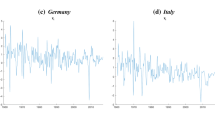Abstract
The changing relationships between the G-7 countries are examined through VAR models for quarterly growth, estimated over sub-periods and using a rolling data window. Trivariate models are employed, each including the US and a European (E15) aggregate. The results show that conditional volatility of growth has declined relatively more since 1980 for E15 than for the US, aggregate European shocks have increased impact on “core” European countries from around 1980, the effects of the US on Europe are largest during the 1970s and the late 1990s, and E15 has a steadily increasing impact on the US economy over time.
Similar content being viewed by others
References
Artis, M.J. and W. Zhang (1997) “International Business Cycles and the ERM: Is There a European Business Cycle?” International Journal of Finance and Economics 2:1–16.
Artis, M.J. and W. Zhang (1999) “Further Evidence on the International Business Cycle and the ERM: Is there a European Business Cycle?” Oxford Economic Papers 51:120–132.
Benati, L. and H. Mumtaz (2005) “The Great Stability in the UK.” Bank of England, mimeo.
Bordo, M.D. and T. Helbling (2004) in Siebert, H.: (ed.), Macroeconomic Policies in the World Economy, Springer-Verlag: Heidelberg.
Doyle, B. and J. Faust (2002) “An Investigation of Co-Movements Among the Growth Rates of the G-7 Countries,” Federal Reserve Bulletin October, 427–437.
Forni, M. and L. Reichlin (1996) “Dynamic Common Factors in Large Cross-Sections.” Empirical Economics 21:27–42.
Helbling, T. and T. Bayoumi (2003) “Are They all in the Same Boat? The 2000–2001 Growth Slowdown and the G-7 Business Cycle Linkages.” IMF Working Paper WP/03/46.
Hoffmann, M. (2004) “Comment” on the paper by Bordo and Helbling in Siebert, H: (ed.) Macroeconomic Policies in the World Economy Springer-Verlag: Heidelberg.
Inklaar, R. and de J. Haan (2001) “Is There Really a European Business Cycle?: A Comment.” Oxford Economic Papers 53: 215–220.
International Monetary Fund (2001) “International Linkages: Three Perspectives.” World Economic Outlook, October, 65–104.
Kim, C.-J. and C.R. Nelson (1999) “Has the US Economy Become More Stable? A Bayesian approach based on a Markov-switching model of the business cycle.” Review of Economics and Statistics 81: 608–616.
Kim, C.-J., C.R. Nelson and J. Piger (2004) “The Less Volatile US Economy: A Bayesian Investigation of Timing, Breadth and Potential Explanation.” Journal of Economic and Business Statistics 22: 80–93
Kose, M.A., C. Otrok and C.H. Whiteman (2003) “International Business Cycles: World, Region and Country-Specific Factors.” American Economic Review 93:1216–1239.
Lumsdaine, R.L. and E.S. Prasad (2003) “Identifying the Common Components of International Economic Fluctuations: A New Approach.” Economic Journal, 113:101–127.
McConnell, M.M. and G. Perez-Quiros (2000) “Output Fluctuations in the United States: What has Changed Since the Early 1980s.” American Economic Review 90:1464–1476.
Monfort, A., J.P. Renne, R. Ruffer and G. Vitale (2004) “Is Economic Activity in the G7 Synchronized? Common Shocks Versus Spillover Effects.” CEPR Working Paper No. 4119.
Norrbin S.C. and D.E. Schlagenhauf (1996) “The Role of International Factors in the Business Cycle: A Multi-Country Study.” Journal of International Economics 40:84–104.
Perez, P.J., D.R. Osborn and M. Sensier (2005) “Business Cycle Affiliations in the Context of European Integration.” Applied Economics forthcoming.
Stock J.H. and M. Watson (2002) “Has the International Business Cycle Changed and Why?.” NBER Macroeconomics Annual 17:159–218.
Stock J.H. and M. Watson (2005) “Understanding Changes in International Business Cycle Dynamics.” Journal of the European Economic Association 3:986–1006.
Treasury, H.M. (2003) UK Membership of the Single Currency – An Assessment of the Five Economic Tests CM 5776 London: HMSO, June.
van Dijk, D., D.R. Osborn and M. Sensier (2002) “Changes in the Variability of the Business Cycle in the G7 Countries.” Centre for Growth and Business Cycle Research, University of Manchester, Discussion Paper 16.
Author information
Authors and Affiliations
Corresponding author
Additional information
JEL Classification Numbers: E32, F02, F43
Rights and permissions
About this article
Cite this article
Perez, P.J., Osborn, D.R. & Artis, M. The International Business Cycle in a Changing World: Volatility and the Propagation of Shocks in the G-7. Open Econ Rev 17, 255–279 (2006). https://doi.org/10.1007/s11079-006-6811-8
Issue Date:
DOI: https://doi.org/10.1007/s11079-006-6811-8




